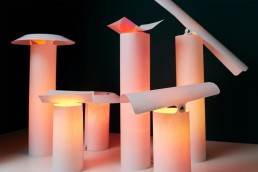
Meet the New Designers: Oscar Parkinson

New Designers is an annual exhibition that brings together graduate design talent from across the UK, which made its return to the BDC in London for its 39th year. The event featured the work of 3,000 graduates from over 100 universities.
Continuing our Q&A series covering emerging decorative lighting designs from the event, darc speaks with the Made.com Stand Out winner Oscar Parkinson who made waves with his Riso printed paper lights.
To read our first Q&A in the series with designer Holly Munro and to find out more about the New Designers awards, click here.
Can you share a bit about your background and what led you to pursue a career in design?
I just finished up my BA in product and furniture design at Kingston School of Art (KSA), before which I did an art foundation (also at KSA). In my foundation year I studied visual communication, which led me to start a graphic design course. I learnt a lot from these two years, but when I was extruding letterforms to try and make benches, I started to reconsider which course was right for me. So, I switched over to product and furniture design, which was a much better fit for me. I’m definitely most suited to the world of 3D design.
What significance does winning the New Designer Award hold for you, and how will it impact your career?
Winning an award from Made.com at New Designers awards was a big surprise for me and it was nice to have a series of paper lights recognised by such a large brand that is probably best known for its furniture. It has given me a lot of confidence in my ability and the kind words from the MADE team about the project have definitely made me want to take the project forward and formalise it into a fully formed product.
What inspired you to create a lighting collection specifically?
I’ve found myself designing lighting quite a lot over the duration of my course. I particularly love how it can transform the atmosphere of a space in a way that other designed objects often cannot. I also love how light can bring out properties of materials that are hidden under normal circumstances, something which the Riso series explores in particular with paper and print.
Could you elaborate on the inspiration and creative process behind your award-winning design?
The Riso collection is a series of six paper lights that celebrate the process of risograph printing. A quick and affordable form of ‘digital screen printing’, the riso machine prints colours one at a time in layers that can be built up to form new tones. The paper shades are all printed on the inside, protecting the delicate prints from smudging, as the soy-based ink never fully dries, which leads to an element of surprise when the light turns on and the print is revealed. Lots of the design was informed by the restrictions of the riso machine such as the paper weight, which is the heaviest the riso machine can print on; and size, as all elements have to be able to fit on either A3 or A4. The patterns themselves are informed by either the way the light falls on the paper (in a gradient), paper archetypes (the grid), or the mixing of ink layers (overlapping strokes).
Which environment is your product best suited to, and why? For example, the hospitality market, residential, somewhere else?
I think the Riso lights are best suited to the domestic environment as they create a cosy atmosphere with the orange and pink from the prints creating a warm light. Although I wouldn’t want to limit their application if someone saw potential in them that I haven’t.
Does sustainability and responsible design influence your design choices and processes?
With the ink being soy-based, that sustainable aspect of risograph printing was a big draw for me to start testing for the Riso lights. I wanted to build on that, with every element of each design being able to be replaced if damaged. I could have glued the paper shade to the bases for example but decided to keep them separate to hopefully encourage users to simply replace the shade rather than throw away the whole thing if it became damaged.
Do you see yourself continuing in the field of lighting design, or do you have other areas of interest you would like to explore in the future?
I would love to keep designing lights and have a couple of ideas in the pipeline alongside developing the Riso lights. I would love to do something on a larger scale to see how that could affect a space differently to the smaller scale I’ve been working on so far. A site-specific project where I can try and create an atmosphere for a particular crowd or activity would be really fun. I do love designing beyond lighting as well though and want to keep the space to design products and furniture in all its forms.
What are your aspirations for the next five years?
I’m just going to see where the next five years take me, I don’t have a specific plan to follow. I want to get as much experience as possible in a wide variety of working environments and see what clicks with me as a way of working and thinking. I would love to keep my own projects going alongside working for other people, so hopefully I can find the space and time for that. I still believe it’s really valuable to learn what you don’t want to do as well as what you do, and I just want to keep a sense of design community and surround myself with people who are up for a good chat about design.



